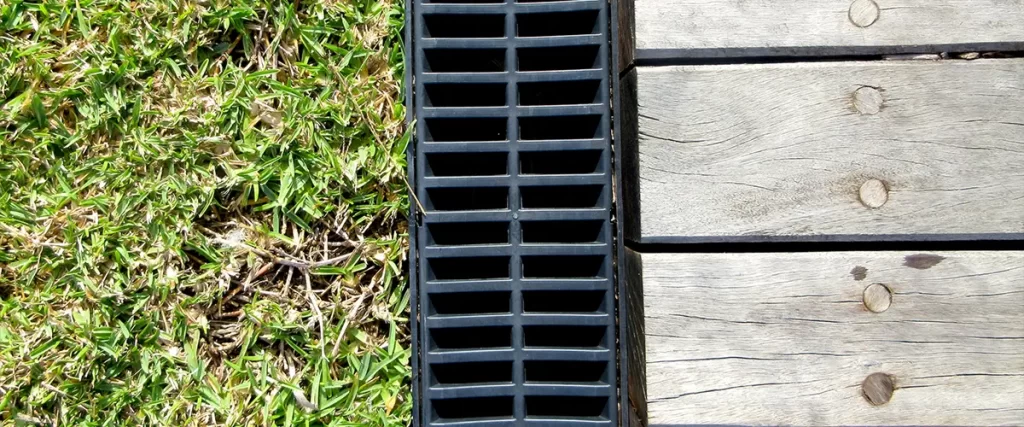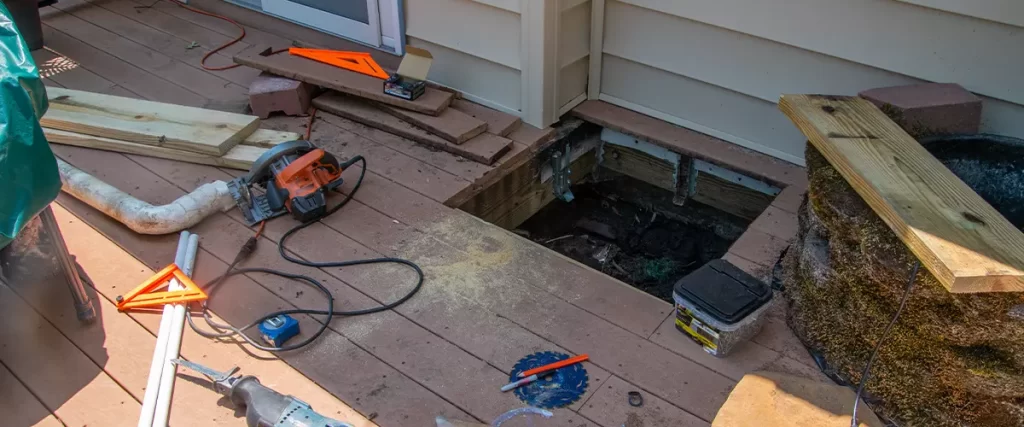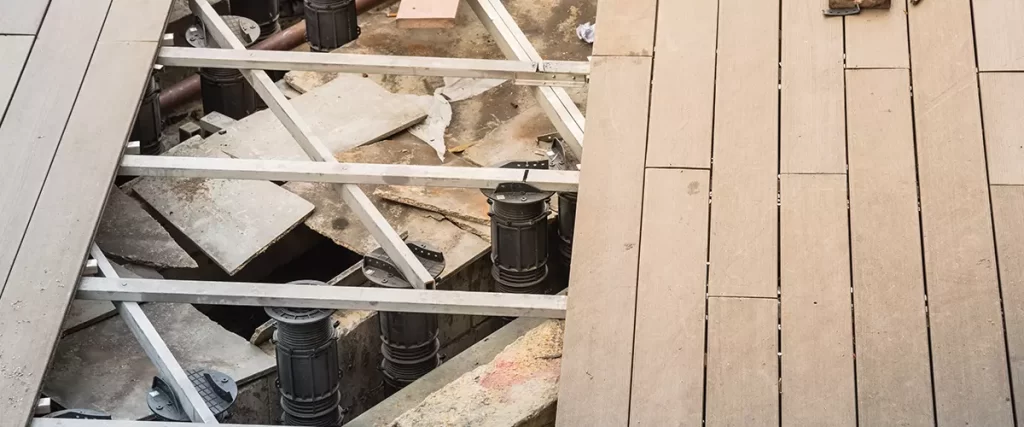You love your deck, your outdoor oasis where family dinners, morning coffees, or evening hangs happen. But when those heavy Midwestern storms roll in, your deck can turn from paradise into a slippery, waterlogged nightmare fast.
No one wants a warped, moldy, or damaged deck thanks to poor drainage. That’s why Omaha deck drainage is hands-down one of the smartest investments you can make in your outdoor living space.
In this article, you’ll dive into everything you need to know about drainage, waterproof deck Omaha strategies, and how to design decks that survive and thrive under relentless rain. Let’s get your deck storm-ready and durable for years to come.

Why Deck Drainage Is Critical in the Midwest
The Midwest, including Nebraska, sees frequent heavy rain, especially from April through June. Sometimes, systems stall and drop inches of rain overnight. That moisture accumulates quickly around and under your deck, creating a higher risk of:
- Wood rot and mold
- Structural instability
- Slippery surfaces and algae growth
On top of that, local building codes require proper water management near foundations and structures to prevent damage. Not taking drainage seriously? You’re risking costly repairs later and possibly code violations. So let’s talk solutions!
Understanding How Water Affects Your Deck
Before jumping into drainage solutions, it’s key to know exactly where and how water does damage:
1. Surface Water
Raindrops directly wet boards, seams, and fasteners. This slows drying and promotes rot or mold.
2. Underneath Water
Water seeping down between boards or that drips from above can pool under the deck. Over time, that leads to exposed joists and structural decay.
3. Water Near Footings
Stagnant water around footings or posts can lead to soil erosion or even shifting foundations if drainage is ignored.
Design Features for Superior Deck Drainage
Here’s the secret: proactive design keeps water OUT of the problem areas. Let’s walk through the most effective features.
Slope and Pitch
Ensure deck flooring slopes just 1/8″ to 1/4″ per foot away from your home. It’s a subtle slope, but it makes a world of difference in channeling water outward.
Gutter-Like Grooves & Hidden Fasteners
Grooved decking surfaces and hidden fastener systems help water shed quickly without accumulating debris.
Under-Deck Drainage Systems
Install a water-collection system under the deck using:
- Under-deck ceiling panels
- Drainage troughs
- Waterproofing membrane
These guide water to gutters or drains, creating a dry space underneath.
Waterproof Deck Coatings
Transparent or semi-transparent waterproof sealers penetrate the wood and repel moisture. For composite decks, apply manufacturer-recommended protectants.
Adequate Flashing at the Ledger
Flashing along the ledger board (where deck meets home) keeps water from seeping behind boards and causing rot in your home’s structure. It’s critical and often overlooked.
Proper Gutter and Downspout Integration
Connect under-deck drainage to gutters, directing water safely away from your home and landscaping.
Maintenance: Keep Drainage Systems Working Strong
A great drainage system needs ongoing care to function well.
- Clean gutters and troughs at least twice a year.
- Sweep off debris from the decking and between the boards.
- Inspect flashing annually for damage or gaps.
- Check footer areas for pooling or signs of wet soil.
- Reapply sealant every few years or as recommended.
These simple actions ensure water drains rather than damages.

Best Products & Manufacturers for Deck Drainage Systems
To build a truly waterproof deck in Omaha, pick quality products that deliver reliable drainage and protection.
Top Manufacturers of Deck Drainage Solutions
These brands offer trusted products that prevent water damage and keep decks structurally sound.
- Trex RainEscape: Under-deck drainage system directing water effectively
- Berger Building Products: High-grade waterproof membranes for decks and patios
- Protecto Wrap: Premium flashing tape and accessories for ledger protection
- TimberTech: Composite materials with superior water resistance
- James Hardie: Exterior siding and trims that work well with deck waterproofing
Why Our Team Excels in Omaha Deck Drainage & Waterproofing
We’ve been designing and installing waterproof deck systems for years. Our team understands Midwestern weather challenges and local building standards. We combine the best materials, precision installation, and ongoing support that saves you money in the long run.
If you’re ready to get your project tackled by our team of industry experts, contact us at (402) 369-5724 so we can get started.
Case Study: Turning Wet Deck Woes into Dry Success
Let’s illustrate how these principles come together:
Scenario:
A homeowner had standing water under their elevated deck after heavy rains, causing joist rot and mosquito breeding.
Our Approach:
- Installed Trex RainEscape under-deck drainage system
- Upgraded waterproof ledger flashing with Protecto Wrap
- Sloped deck boards and replaced worn sealant
- Connected drainage to downspouts and improved yard slope
The Result:
A dry, clean under-deck space, a stable ledger, and no excess water around footings even during storms.

Frequently Asked Questions
How much should my deck slope for drainage?
A gentle slope of 1/8″ to 1/4″ per foot away from the home is sufficient to guide water off the surface.
Are under-deck drainage systems worth it?
Yes, especially for second-story decks. They protect joists and provide livable space below.
Can I waterproof my deck myself?
You can reseal deck boards, but installing under-deck systems and flashing is best left to professionals for proper application.
How often do I need to reapply sealant?
Generally, every 2–3 years, or per the manufacturer’s instructions. Always clean the deck before resealing.
How do I know if my flashing is failing?
Signs include soft boards or rotting near the ledger. Water stains or mold suggest flashing issues.
Will drainage systems reduce insect problems too?
Yes, dry spaces underneath mean fewer mosquitoes and no standing water around footings.
What’s the lifespan of deck membranes or under-drain products?
Most high-quality membranes last 15–30 years. Inspect periodically for damage or wear.
Do I need a permit for drainage upgrades?
Check with your local building authority. Many durable deck upgrades don’t require permits, but flashing and attachments might.
Final Thoughts on Omaha Deck Drainage & Waterproofing
Heavy Midwest weather doesn’t have to mean a damaged, moldy, or unsafe deck. With the right slope, materials, flashing, and drainage systems, your deck can stay dry, stable, and enjoyable rain or shine.
Ready to build or upgrade your deck with confidence? Our team is here to make it happen smoothly, smartly, and up to local code. Contact us at [cgv tel] and let’s start your deck-building project
Want help choosing the right system for your deck or a free inspection? Contact us, we’re happy to guide you to a dryer, stronger deck for years to come.
